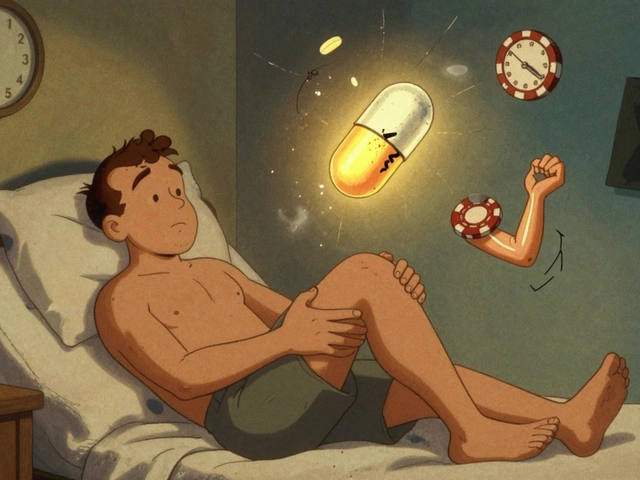Tricor (Fenofibrate) Guide: Uses, Dosage, Side Effects & FAQs
Trying to get your cholesterol under control can feel like navigating a maze of pills, lab tests, and endless doctor visits. One name you’ll bump into often is Tricor, a prescription drug that many prescribe to lower triglycerides and raise good HDL cholesterol. This guide cuts through the jargon, shows you exactly how Tricor works, what the right dose looks like, which side effects to watch for, and how to keep it safe with other meds you might be taking.
- Quick answer: Tricor is a brand name for fenofibrate, a lipid‑lowering medication.
- It mainly lowers triglycerides and can modestly raise HDL (the "good" cholesterol).
- Typical adult dose is 145mg once daily with a meal, but your doctor may adjust it.
- Common side effects include stomach upset, muscle aches, and elevated liver enzymes.
- Never start or stop Tricor without consulting your healthcare provider, especially if you have kidney disease or take statins.
What Is Tricor and How Does It Work?
Tricor is the trade name for fenofibrate, a member of the fibrate class of drugs. Unlike statins that primarily block cholesterol production, fenofibrate activates a protein called peroxisome proliferator‑activated receptor‑α (PPAR‑α). This activation does three things:
- Speeds up the breakdown of triglyceride‑rich particles (VLDL) in the liver.
- Increases the production of HDL particles, helping clear cholesterol from your bloodstream.
- Improves the way your body processes fatty acids, lowering overall lipid levels.
Because it works through a different pathway, Tricor can be a handy complement to statins for patients whose triglycerides remain high despite statin therapy.
Who Should Take Tricor? Indications and Contra‑indications
Doctors prescribe Tricor for adults who have:
- Elevated triglycerides (≥200mg/dL) that haven’t responded to diet and exercise.
- Low HDL cholesterol (<40mg/dL for men, <50mg/dL for women) alongside high triglycerides.
- Mixed dyslipidemia where both triglycerides and cholesterol need correction.
It’s NOT for everyone. Avoid Tricor if you have any of the following:
- Severe liver disease (ALT/AST >3× upper limit).
- Kidney failure requiring dialysis.
- Allergy to fenofibrate or any component of the tablet.
- Active gallbladder disease (fenofibrate can worsen gallstones).
Women who are pregnant or nursing should not use it because animal studies show potential fetal harm.
Dosage, Formulations, and How to Take It Right
The most common brand formulation is a 145mg tablet taken once a day with a main meal. Eating with food improves absorption and reduces stomach upset.
| Formulation | Strength (mg) | Typical Adult Dose | Special Instructions |
|---|---|---|---|
| Immediate‑release tablet | 145 | 1 tablet daily with breakfast | Take with a high‑fat meal for best absorption |
| Extended‑release capsule | 160 | 1 capsule daily with any main meal | Do NOT crush or chew |
| Micronized powder (for compounding) | 50 | Based on physician’s compounding order | Usually mixed into a soft food |
Key dosing tips:
- Never split a tablet unless your doctor explicitly says it’s okay.
- If you miss a dose, take it as soon as you remember-unless it’s almost time for your next dose, then skip the missed one and continue as normal.
- Check liver and kidney labs before starting and periodically (every 3‑6 months) while on therapy.

Side Effects, Interactions, and Safety Checklist
Most people tolerate Tricor well, but be on the lookout for these common issues:
- Gastrointestinal: Nausea, abdominal pain, or diarrhea-usually mild and improve after a week.
- Muscle problems: Myalgia or, rarely, rhabdomyolysis (especially when combined with statins). Report any unexplained muscle weakness or dark urine.
- Liver enzymes: Elevated ALT/AST. Your doctor will monitor these with blood tests.
- Kidney concerns: Increased creatinine; stay hydrated and have renal function checked.
Serious but rare reactions include severe skin rashes, gallbladder inflammation, and hypersensitivity. Seek medical help if you notice swelling of the face, difficulty breathing, or a sudden rash.
Drug interactions to watch:
- Statins (especially high‑dose simvastatin) - higher risk of muscle toxicity. \n
- Warfarin - fenofibrate can increase INR; monitor clotting numbers.
- Cyclosporine - may raise fenofibrate levels and strain kidneys.
- Oral contraceptives - can increase triglycerides; watch labs.
Always hand your pharmacist a complete list of meds, supplements, and herbal products.
Frequently Asked Questions
- Can I take Tricor if I’m already on a statin? Yes, many doctors prescribe both, but they’ll start at a low statin dose and watch for muscle symptoms.
- How long before I see results? Triglyceride levels usually drop 20‑50% within 4‑8 weeks; HDL may rise modestly after 12 weeks.
- Do I need to continue taking Tricor for life? If your diet, weight, and exercise keep lipids in target range, your doctor might taper off, but most people stay on it long‑term.
- Is Tricor safe for seniors? Dosing may need adjustment for reduced kidney function; doctors often start at a lower dose.
- Can I drink alcohol while on Tricor? Moderate consumption is okay, but heavy drinking can raise triglycerides and worsen liver strain.
Next Steps: How to Talk to Your Doctor and Monitor Progress
Armed with this info, schedule a visit with your healthcare provider if you suspect high triglycerides or have been advised to consider a fibrate. Bring these talking points:
- Recent lipid panel results and any previous medications you’ve tried.
- Any history of liver or kidney disease, gallstones, or muscle disorders.
- A list of all current prescriptions, OTC meds, and supplements.
- Questions about lifestyle changes that could boost Tricor’s effectiveness (e.g., omega‑3 intake, weight loss, exercise).
After you start the drug, set up a schedule for lab checks: baseline liver and kidney tests, then repeat at 6‑8 weeks and every 6 months thereafter. Keep a simple log of any new symptoms-especially muscle pain or fatigue-so you can discuss them promptly.If side effects become intolerable, discuss alternatives like prescription omega‑3 fatty acids (e.g., icosapent ethyl) or newer agents such as bempedoic acid.
Bottom line: Tricor can be a powerful tool in the fight against high triglycerides when used correctly. By understanding the dosage, watching for side effects, and staying in sync with your doctor, you’ll give your heart a better chance at staying healthy.







10 Comments
Geneva Lyra
September 21, 2025 at 02:13
Hey folks, just wanted to say that Tricor can be a real game‑changer when diet alone isn’t enough.
I’ve seen friends manage their triglycerides better and feel more energeric.
Remember to keep the conversation open with your doc, and don’t be shy about sharing any side effects you notice.
Moritz Bender
September 21, 2025 at 06:23
From a pharmacodynamic perspective, fenofibrate functions as a peroxisome proliferator‑activated receptor‑α (PPAR‑α) agonist, thereby modulating lipid metabolism at the transcriptional level.
Activation of PPAR‑α upregulates lipoprotein lipase activity, which accelerates the hydrolysis of triglyceride‑rich VLDL particles.
Concomitantly, hepatic fatty acid oxidation is enhanced, reducing substrate availability for de novo lipogenesis.
The net effect is a quantitative reduction in circulating triglycerides, typically in the range of 30‑50% depending on baseline values.
Moreover, the drug modestly elevates HDL‑C by facilitating the maturation of nascent HDL particles.
Clinically, these biochemical shifts translate into a lowered atherogenic risk profile, especially in patients with mixed dyslipidemia.
It is worth noting that fenofibrate’s efficacy is synergistic with statins, as the latter primarily inhibit HMG‑CoA reductase, whereas fenofibrate addresses the triglyceride axis.
However, pharmacokinetic interactions can occur; for instance, concomitant use of gemfibrozil may precipitate a tenfold increase in fenofibrate plasma concentrations, necessitating dose adjustments.
Renal clearance plays a pivotal role, so dosage must be titrated in patients with chronic kidney disease to mitigate the risk of accumulation.
Adverse event monitoring should include hepatic transaminases, serum creatinine, and creatine kinase, given the documented incidence of myopathy when combined with high‑intensity statins.
Patients often report mild gastrointestinal discomfort, which can be alleviated by ingesting the tablet with a substantial meal.
If muscle pain or unexplained fatigue arises, clinicians should evaluate for rhabdomyolysis promptly.
Long‑term outcome studies such as the FIELD trial provide evidence of cardiovascular benefit, albeit modest compared to statin monotherapy.
From a therapeutic algorithm standpoint, fenofibrate is typically reserved for individuals with triglycerides >200 mg/dL who have not achieved target levels despite lifestyle modification.
Lifestyle interventions remain foundational; pharmacotherapy should complement, not replace, dietary fat reduction and exercise.
In summary, Tricor offers a mechanistically distinct avenue to address residual hypertriglyceridemia, and when used judiciously, it can be an integral component of a comprehensive lipid‑lowering regimen. 😊
Nicole Hernandez
September 21, 2025 at 10:33
I appreciate the thorough yet accessible overview of fenofibrate’s mechanism of action.
It is reassuring to see that the medication targets triglyceride metabolism through a pathway distinct from statins, providing an additional tool for clinicians.
Patients should be reminded that adherence to dietary recommendations remains essential, even when pharmacotherapy is introduced.
Overall, the guide balances scientific detail with practical guidance, which is exactly what many of us need.
florence tobiag
September 21, 2025 at 14:43
But really, who trusts a drug that was invented in the 1970s???!!!
Terry Washington
September 21, 2025 at 18:53
Let’s cut through the fluff: Tricor is not some miracle pill, it’s a chemically engineered PPAR‑α agonist that demands respect.
If you think you can gulp it down without monitoring liver enzymes, you’re courting disaster.
Only patients with documented hypertriglyceridemia should even contemplate this regimen, and they must do so under strict medical supervision.
Ignore the hype, focus on the data, and demand accountability from your prescriber.
Claire Smith
September 21, 2025 at 23:03
While the article is exhaustive, it borders on verbosity, making it cumbersome for a lay reader seeking quick answers.
Émilie Maurice
September 22, 2025 at 03:13
Tricor is a brand name for fenofibrate. The article correctly states that it lowers triglycerides and can raise HDL. However, the phrase “raise good HDL” is redundant; HDL is already considered beneficial. Also, “never start or stop Tricor without consulting your healthcare provider” should be a separate sentence for clarity.
Ellie Haynal
September 22, 2025 at 07:23
Listen up, because this is important: taking Tricor without proper oversight is a slippery slope toward neglecting the fundamentals of health.
We cannot excuse ourselves by hiding behind a prescription while ignoring diet, exercise, and regular check‑ups.
Every time you skip a lab test, you gamble with your liver and muscles.
It’s not just about numbers on a chart; it’s about honoring your body and the responsibility you have to yourself and your loved ones.
So if you’re on Tricor, stay vigilant, stay informed, and never let convenience trump caution.
Jimmy Gammell
September 22, 2025 at 11:33
Yo buddy, good job on looking into Tricor!
Just remember to take it with a big meal so your stomach dont get upset :)
If you feel any weird muscle aches, hit up your doc ASAP.
Stay consistent with your diet and keep those labs on track, you got this!
fred warner
September 22, 2025 at 14:20
Absolutely, staying on top of monitoring is key, and it’s great that you’re emphasizing the bigger picture of health.
Keep the momentum going, and remember that every responsible step you take with Tricor brings you closer to those cholesterol goals!